3. Value of Ethanol as an Internal Combustion Engine (ICE) fuel
3.1. US EPA ethanol fuel studies
The EPA has been studying the effects of ethanol (and methanol) at all levels, from research into their maximum benefit, to estimating the mileage differences they resulting in. In this chapter we focus on have ethanol effects existing vehicles. In Chapter 4 we will discuss how much better engine performance will be when used in engines that take its benefits into consideration, rather than let those qualities go out the tailpipe.
The benefits of ethanol relative to race fuel and/or methanol are multifold, but let's start with the one many of you already have guessed - power and performance. A typical (R+M)/2 octane rating of E85 is around 100. The naturally high octane allows for greater compression and expansion ratios - the power and efficiency benefits to the racer of higher octane are well known and widely published.
Second, ethanol has a higher heat of vaporization relative to gasoline-a significantly higher value. A typical heat of vaporization for gasoline may be on the order of 59 kilojoules per kilogram of fuel. For ethanol, it's approximately 130 kilojoules per kilogram, which is more than twice that value for gasoline.
The energy required to vaporize the fuel comes mostly from the air, but a portion actually comes from engine intake surfaces as the fuel vapor contacts it. However, it is most ideal to use as much of the air for vaporization to maximize volumetric efficiency. If a fuel has a higher heat of vaporization, the intake air temperature will be reduced, resulting in better volumetric efficiencies as the inlet charge has a higher density. From this, one would expect significant gains in torque performance with ethanol relative to gasoline, and this will be shown to indeed be the case.
In published research work conducted by General Motors, full-load data of a four-cylinder, naturally aspirated spark-ignition direct-injection flex-fuel engine running on E85 demonstrated a near 15 percent increase in specific output relative to production gasoline counterparts, while showing an improvement in part load operation of 3-6 percent. These gains were associated with reduced heat rejection, increased volumetric efficiency, and increased dilution (EGR) tolerance.
Beyond the power benefits that ethanol can provide there are two other big factors that make ethanol an attractive fuel for circle track applications. First, it's renewable; and second, it's clean-burning. In addition, since ethanol is less volatile than gasoline, there's a reduced chance of explosion in spills and accidents. And although ethanol is more corrosive than gasoline to certain materials, it is less toxic to the user.
The production of ethanol today is energy positive at nearly 2 to 1. If you take that energy to a volume then we produce 2.8 gallons of ethanol for every gallon gasoline.
But perhaps as important as all of the above is that ethanol displaces aromatics, the most expensive part of gasoline and the most hazardous. The VOC’s, PM, PAH & SOA’s can find its roots from the Benzene, Toluene and Xylene of aromatics. A result is that E10 is 20 to 30 cents cheaper. But the oil companies will never tell you that E10 is, since they don’t want to disrupt the petro chemical market.
Ethanol is more efficient as well since most FFV’s will loss 15 to 20 percent mileage with consistent E85 fueling, all the while having 28 percent less energy in the tank.
But things could easily get better. Current engines are engineered to operate on low-octane fuels. Typical unleaded fuel measures at about 87 octane while, by comparison, a fuel comprised of 98 percent ethanol, has octane levels ranging from the upper 90s to low 100s. Because gasoline has dominated the transportation fuels sector since automakers began mass producing vehicles, engines have been optimized for low-octane fuels. In order to experience the true benefits of ethanol, engines need to be optimized for increased fuel compression. This would result in improved mileage and greater efficiency, experts say, and would benefit E85 as well as midlevel blends. “If we could get the manufacturers to put additional software in the computers to be able to run on, let’s say E30 as well as E10, they could change the timing in the computer program and get the same mileage as you get on gasoline,” Bob Kozak, cofounder of the nonprofit biofuels educational group Advanced Biofuels USA says.
3.1.1. Reformulated Gasoline Contains 10% Ethanol
Since the 1970s about 10% ethanol has been in the fuel we call 'gasoline'. It was part of the aromatics Benzene, Toluene, and Xlyene added to replace lead. The lead was deadly to our brains. Important for you to know, for the educational goals we are seeking, is that the auto industry and the oil companies DID NOT remove the lead added to gasoline for 5 decades, even though they new the lead was dumb all of us down - to say the least. The only reason they got the lead out was that the EPA required catalytic converters on all vehicles to reduce the general level of emissions, and the lead added to gasoline killed the catalytic converters.
3.1.2. US Ethanol Mandates
To meet the 2007 Renewable Fuels Standard (RFS) Federal Mandate, we must use more ethanol than, it appears, the number of Flex Fueled vehicles being made will require. Thus the EPA is raising the amount of ethanol it will allow more of it to be sold in gasoline. First the picture in a nutshell looks like:
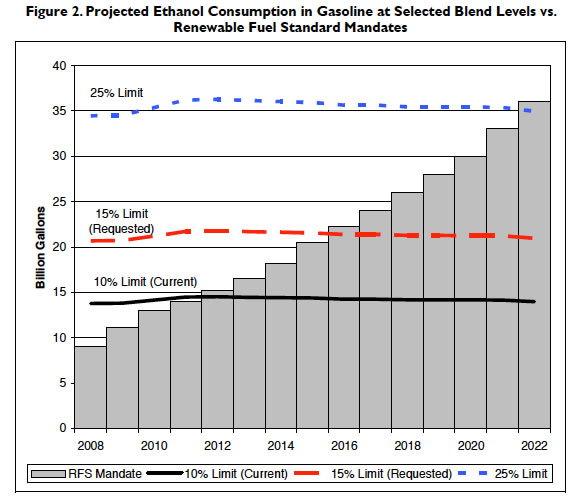
If we maintain the 10% ethanol limit, we will be on the black line. The requirement is the dark grey bars. Going to 15% ethanol we move to the red line. By 2022 we are supposed to be able to use approximately 25% in our vehicles (36 billion gallons is the mandate).
3.2 Value of using ethanol in existing vehicles
Recently the EPA has approved an increase of ethanol to 15% in reformulated gasoline, for vehicles model year 2001 and newer. This is about 130,000,000 in the US (out of 250,000,000). Years earlier the world's research community had reached the conclusion that no damage would be done to vehicles. However, there is a vocal outcry from the oil industry. Furthermore, they have gathered their allies, and of all organizations, the AAA, to warn that older vehicles will suffer. We will look into this soon.
3.2.1 What is story of using E15? Will you pay more to get less, or will you benefit?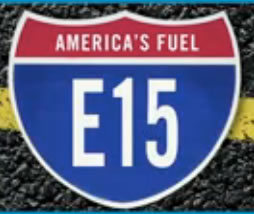
From Farm Progress.com Oct. 2012: "Robert White of the Renewable Fuels Association says time will tell how fast E15 gains market share, but that it is worth noting that at the stations where it is sold, it is the highest-octane gasoline sold — comparable to premium — and it is sold at the cheapest price."
A DOE web page states the fuel economy drops for mid-level ethanol blends. The average measured fuel economy drop (decrease in miles per gallon) was stated to be 3.7% with E10, 5.3% with E15, and 7.7% with E20 when compared with gasoline. Using 85% ethanol, E85, and an Oak Ridge National Laboratory report found flexible fuel vehicles using E85 experienced a 27% drop in fuel economy when compared with conventional gasoline. These are of course the official government estimates. see http://feerc.ornl.gov/pdfs/pub_int_blends_rpt1_updated.pdf(PDF). "Effects of Intermediate Blends on Legacy and Small Non-Road Engines", National Renewable Energy Laboratory and Oak ridge National Laboratory, February 2009. Discussing this we find that the EPA numbers look identical to the decrease in mileage one would calculate by just assuming it is exactly the same as the decrease in energy per unit volume found in the ethanol blends. But, as you can see below this is not what happens in the real world.
Vander Griend head of ICM Inc.’s research and development of ethanol engines (ICM is the leading the research effort in Detroit, which is focused on testing the actual fuel) and others say ethanol testing conducted by the U.S. EPA and U.S. DOE does not accurately display ethanol’s benefits because the agencies often use indolene, a form of standardized gasoline, as the blend fuel rather than the conventional gasoline available to consumers. “It is virtually impossible to identify fuel ethanol testing protocols in which ethanol is simply added to gasoline; in government study after government study the base gasoline makeup is changed when tests are performed with ethanol,” Vander Griend recently stated. “It is time for the domestic ethanol industry to better understand the value of ethanol, learn how it is tested, and then offer solutions that deliver the most benefits. Ethanol offers much more value than it is traditionally given credit for, as far as improving efficiency and reducing emissions. However, current policy and regulatory challenges have hidden a significant part of what ethanol has to offer.”
Because the presence of ethanol makes the engine behave differently, these theoretical estimates, and EPA tests don't hold across the board, or hold in general! Clearly, see below, some vehicles get better mileage using intermediate blends.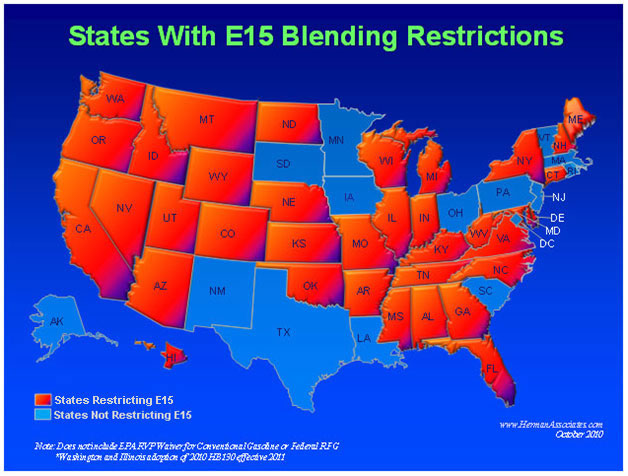
At the moment a large number of states have legislation that is blocking even this modest increase in ethanol (see map below). We hope that science, not politics will inform this next small move forward.
3.2.2. Studies of the Effects of 15%, 20%, 30% and Higher Ethanol Addition to Gasoline in Both Flex-Fueled and Non-Flex Fueled Vehicles
We are told that we can't use blends other than the E10 that is everybody's 'regular gas' and E85 made for Flex Fueled vehicles. Well this a a great disservice to us and to our country. As we shall see below, higher blends on ordinary vehicles may give you better value, and lower blends in Flex Fueled vehicles may also give you better value.
As things stand now, you can certainly legally put lower blends in your Flex Fueled vehicle (but you are not told by the auto companies anything about at what blends your car will run best), but you experiment - (read below first). How would you experiment if there are not blender pump in your area? Well, for example with 1/2 a tank of gasoline, fill the rest with E85, and check whether your mileage as change for the better or worse. When you find it better, like some E85 Yukon drivers do, you will start wondering why you are not given this info by your auto company.
3.2.2.1. The Minnesota Study and the Phenomenon of an Optimum Blend of Ethanol in Gasoline
In a fascinating study done by the University of North Dakota and the Minnesota State University in 2007 by Shockey and Aulich, it was found that different vehicles had a 'sweet point' in terms of mileage changes using various amounts of ethanol in their gasoline. Amazingly, they tested both Flex Fueled cars and just gasoline cars. Below we show the 'sweet spots' for both a 2007 Flex Fueled Chevy Impala, and a 2007 gasoline Chevy Impala.
Figure 12, below, and the table beneath it show the dramatic occurrence of a 'sweet spot' where the mileage significantly INCREASED when 20% ethanol was mixed in the with gasoline. The red line is the expected decrease in mileage due to the use of ethanol (ethanol, on an equal volume basis, has only 67% of the energy gasoline has). However, the actual mileage was very different. We will explore some of the reasons late (see 3.2.4. "How is it possible..." below). But it clearly argues that the use of E20 in a Flex Fueled Impala is an option to get the best bang for the buck (remember ethanol is cheaper than gasoline), depending on the cost of gasoline. It is giving 15% better fuel economy. However, there is another possible choice for best 'bang for the buck', and that is E50. At E50 the mileage is essentially the same, so the lower cost of ethanol will weigh more against the cost of the 50% gasoline. If driver had the option, then they could determine what was the most economical fuel blend for their vehicle, but clearly certain ethanol blends are going be money winners.
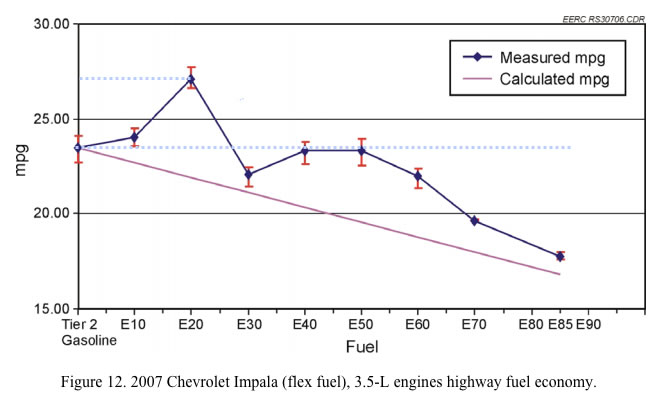
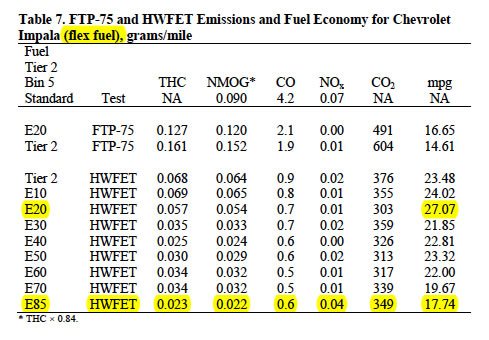
When the same tests were done on a non-flex fuel Chevy Impala, there was also a sweet spot, this time at 40% ethanol. As the table shows, at E40, there was only a slight decrease (24.51 to 23.30) in gas mileage, again less than the theoretical decrease. In this case note that using 40% ethanol also defied the theoretical decrease, this time by significantly more, even though the mileage went down to 22.65. Now this sets up an interesting situation. If Blender Pumps existed, one would have to calculate whether the cheaper price of E40 over Tier 2 gasoline made it a better deal than the situation found using E20, and again whether either of these was a better deal financially than using straight Tier 2 gasoline. In reality, Brazilians have this flexibility and do these calculations often to save money. Americans, of course, do not have this opportunity, despite the high costs of gasoline we have to pay.
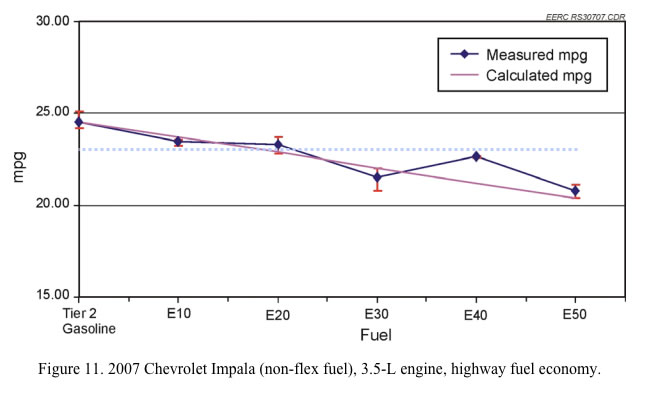
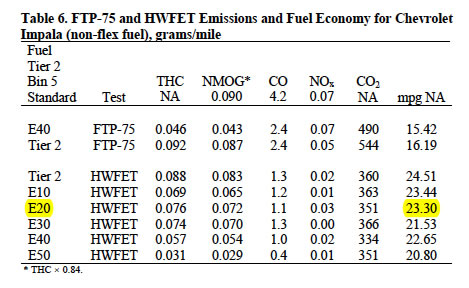
The Impala lost 5% using 20% ethanol in the gasoline, but should have lost 6.5%. Using E40 it lost 7.6% using 20% ethanol, but should have lost 13%. As discussed below many non-flex fueled vehicles have been tested, and roughly half have shown mpg gains at 20% ethanol. A 2005 Impala showed a 1% gain (vs. the 5% loss above).
The results for other non-Flex Fuel vehicles show even better results. Two other non-flex fueled vehicles that were tested are shown below. The 2007 Ford Fusion and the 2007 Toyota Camry both allowed drivers to use E30 with no loss of fuel economy, but, of course, with the savings in cost and emissions, and the reduction in oil use.
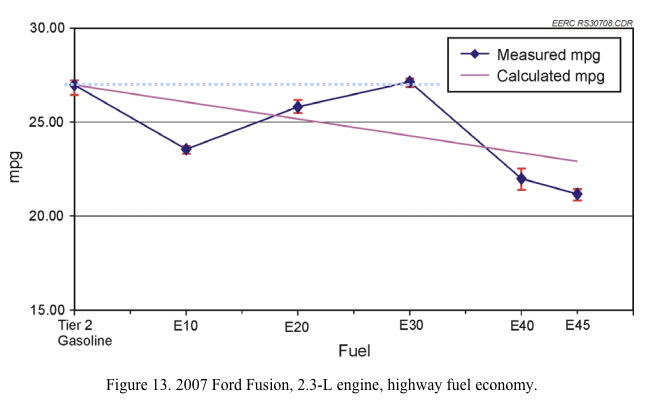
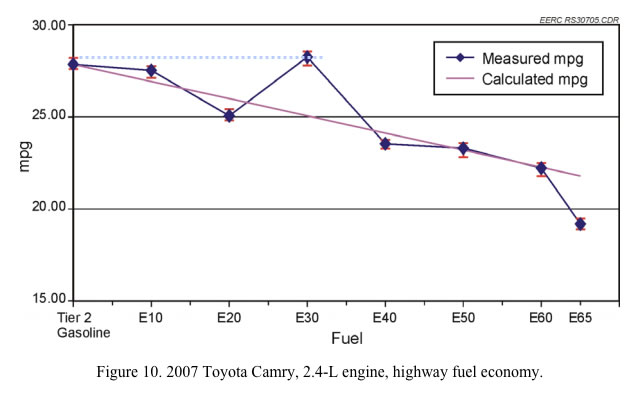
Three things are clear from the above study:
1) Very subtle differences in the way the onboard computer handles the increased amount of ethanol, will determine whether you get a gain or loss of mileage at all of the blends tested. Thus, if automakers 'tuned' their computer programs to using ethanol, many more vehicles could take advantage of its properties.
2) Based on the Minnesota studies (see more below) it certainly appears that stock 'gasoline only' vehicles can use up to E20.
3) Based again on these studies, it may make sense for Flex Fuel vehicle to use a lower fraction of ethanol in their vehicles than E85. U.S. practice has clearly shown that customers shy away from using E85 in these vehicles because they either calculate or use DOE numbers that show the slightly reduced price of E85 does not compensate for the theoretical reduction in mileage. And at E85, as you can see above, the actual mileage does get reduced almost this amount. However, if they used lower blends, of say E20, or E40 or E50 they would be getting a better deal!!! They would be paying less and getting the same or better mileage using these blends in their Flex Fueled vehicles -- if of course, they had this Impala, or a vehicle whose computer behaved similarly.
3.2.3. A larger Minnesota Study using E20 on non-flex fueled ('gasoline only') vehicles
In November 2008 the University of Minnesota issued a Demonstration and Drive ability Project Report to Determine the Feasibility of Using E20 as a Motor Fuel.
Eighty vehicles, consisting of 40 matched pairs, were selected from the University of Minnesota Twin Cities Fleet Services car pool in order to determine whether E20 can be used effectively in current vehicle technology. These were ordinary 'gasoline only' models. The selection of vehicles included a wide cross section of model year 2000 through 2006 Chrysler, Ford, General Motors, and Toyota vehicles; all vehicles were fuel-injected and included hybrid models. The vehicles are part of the University’s system of vehicles that include service vans and are used as standard transportation in both city and highway use. Fuel for this study was commercially available non-oxygenated gasoline and gasoline up blended to 20 % volume with commercially available fuel grade ethanol.
One vehicle in each pair was fueled with non-oxygenated gasoline while the other vehicle in the pair was fueled with 20 percent ethanol blended gasoline. The vehicles were driven over the course of a year to expose the vehicles and the fuels to weather conditions typical of each of the four seasons. Drivers of the vehicles were trained to complete incidents logs to track issues associated with the performance of the vehicles. Blind refueling cards were supplied for each individual vehicle in order to prevent bias toward either fuel. Experts in vehicle derivability performance were brought to Minnesota once each season to provide and assess additional fuel performance data.
It showed, that after 13 months of tests with two of each of 40 vehicles that the following vehicles actually had mileage increases on E20.
Table 1 shows the makes and models tested.
| % change | ||
| 2005 Chevy Malibu | 2% | |
| 2005 Chevy Impala | 1% | |
| 2005 Chevy Astro #1 | 15% | |
| 2000 Chevy Astro #2 | 19% | |
| 2000 Chevy Astro #3 | 6% | |
| 2003 Ford Focus #1 | 6% | |
| 2003 Ford Focus #2 | 24% | |
| 2000 Chevy Express 2500 | 19% | |
| 2001 Ford E250 #1 | 11% | |
| 2001 Ford E250 #2 | 11% | |
| 2006 Chevy Express 3500 | 2% | |
| 2000 Ford F450 | 28% | |
| 2003 Ford E150 | 2% | |
| 2005 Ford Escape Hybrid | 3% | |
| 2005 Chevy Malibu | 2% | |
| 2005 Ford Escape Hybrid | 3% | |
| 2000 Workhorse UCBC | 22% | |
| 2000 Workhorse UCBC | 10% | |
| 2005 Ford Crown Victoria | 4% | |
| 19 | 10% | AVERAGE Mileage Increase |
Remember, a 6.5% loss in fuel economy is suggested by the amount of energy missing from E20. This list includes a number of very popular vehicles. Their average mileage increased by 10% over using gasoline in them. Many of the other vehicles in the tests that had lower mileage would not be considered consumer vehicles or even light duty vehicles, thus we are not concerned with their performance.
The 20 percent ethanol blended fuel proved effective at both powering the vehicles successfully and was also non distinguishable in performance by either the University drivers or the professionally trained drivers.
This study begs the question: why shouldn't car companies enable us to use 20% ethanol, or higher blends, so we can save money?
3.2.4. How is it possible that better mileage can be obtained?
Drivers of flex-fuel vehicles (FFVs), which are approved for midlevel blends, also often report that they experience fewer miles lost when using E30 as compared to E85. Sometimes they say E30 gives them as many miles per gallon as regular unleaded, and it often costs a few cents per gallon less than unleaded. The evidence suggests that E30 may be the optimal blend for vehicles, and it presents an interesting case for improved testing of midlevel blends to determine just how high the ethanol-to-gasoline ratio can be in the nation’s vehicles.
An important supporter of the higher blends is Ron Beazley of Ricardo Consulting, the famous engine company. He said "the EBDI vehicle test program will evaluate performance using various ethanol fuel blends." “We think there’s a blend compromise somewhere between E35 and E50 that gives good performance with good fuel economy, and will prove the cost-competitiveness of this technology.”How is it possible to get better mileage on a fuel with less energy? Remember, the more ethanol that is added to the gasoline, the less energy each gallon of the fuel has in it. The answer is in how it enters the combustion chamber and how well it burns. When alcohol enters the cylinder of your engine, it cools the region as it expands into the chamber. This allows a greater charge of air to enter, enabling more complete combustion. Furthermore, the ethanol component of the fuel burns cooler and faster than gasoline.Thus, less fuel energy is lost via heat transfer, and more of the fuel is burnt during the time available, thus creating more energy to push the piston; rather than having the fuel go out the tailpipe unburned.
The large variation in mileage increases shown is attributable to a number of reasons. Clearly, the way the vehicle was driven will have an impact. But, beyond that, and according to the professor directing the experiments, the flexibility and restraints of the onboard computer program have a role to play. It is suggested that the more adaptable the onboard software, the more likely it will enable the qualities of the ethanol to be utilized. One of the most important flexibilities is the ability of the oxygen sensor and computer software to sense the ethanol, and advance the timing of the engine to account for the much higher octane ethanol has, thus increasing the compression ratio, and therefore the power output.
3.2.5. What about low speed torque?
Computations by Gravalos et al. show that over the range of engine speeds the ethanol blends E10, E20, E30 will give better brake torque than gasoline.
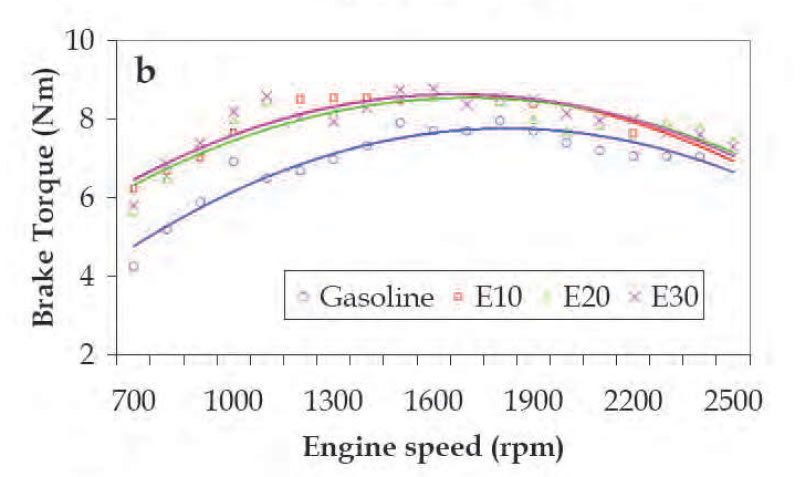
Experiments by Boretti (2010) also show that E100 gives better than 50 Nm of torque than gasoline.
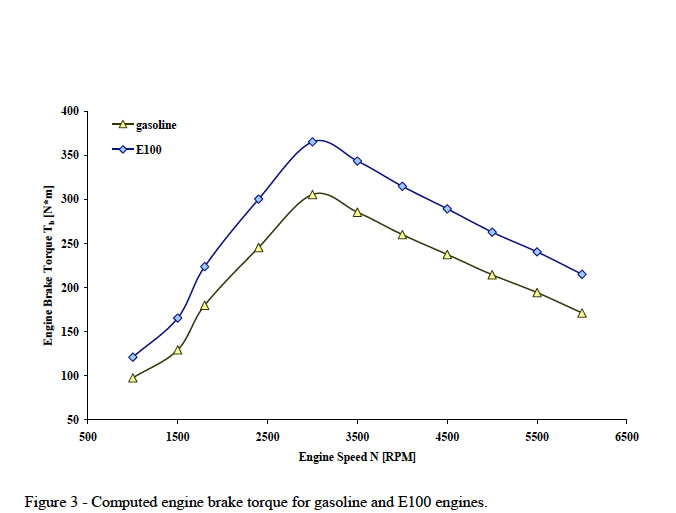
Experiments by Ricardo Engines Company on a dynamometer show that SI engines can achieve higher low speed torque with less cylinder pressure.
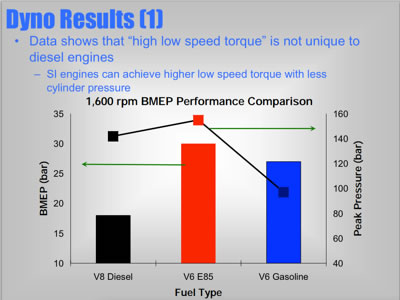
3.2.6. Need for an ethanol 'performance' map for each vehicle
Clearly, from the above figures and tables we can see that if we have such 'performance' data for the vehicles we bought, we could make informed choices that could save us money, and induce us to used less oil.
Perhaps we should ask our dealers about it. Especially if we own Flex Fueled vehicle, and don't use E85 because of the reduced mileage.
There are more options. As we will show in the next chapter, engines can get MUCH better performance when using ethanol, but the auto companies must design around ethanol's strong properties, not around gasoline as the basic fuel.
3.2.7. Can a 'Gasoline Only' Vehicle use these higher blends?
This is a very important question. We will not have the final answer here, but there is mounting evidence that many 'gasoline only' vehicles can use modest amounts of ethanol without any noticeable issues.
For years, in coffee shops and grain elevators across the upper Midwest, independent thinkers have voiced their opinions on the benefits of midlevel ethanol blends. Tales of fueling the old Buick, or otherwise unapproved vehicle, with E20 or E30 without experiencing any of the dire consequences threatened by auto manufacturers are not hard to come by, although getting anyone to report the results of their own private fuel test on the record are not so easy. The nonconformists are often corn farmers eager to use as much ethanol as they can and curious to see what will happen if they bump up the blends. They blend it themselves by partly filling the tank with E85 and finishing it off with E10. Or, when available, they use a blender pump. These types of do-it-yourself experiments are certainly not recommended by the ethanol industry nor by the automakers, who say unapproved fuel use will violate warranty agreements. But the fact is, people do it anyway.
Lets start with a report from the University of Minnesota. Bonnema et al. 1999 https://www.ethanol.org/pdf/contentmgmt/E30_Final_Report.pdf tested 15
3.2.8. How can we use our E85 vehicles to test the intermediate blends of Alcohols?
Steve Vander Griend of ICM says, "Ethanol’s high octane level has been a limiting factor in most previous testing because the limits of the engine are reached before the octane is fully utilized. This is a particularly poignant issue with regard to E85, which is well-known to have more horsepower than regular unleaded, but as yet has been unable to achieve the same efficiency rates. This could likely be due to the fact that engines are simply not able to fully utilize the fuel."
Vander Griend continues "For the average FFV, you will put 28 percent less energy in the tank compared to gasoline, the average mileage loss is only 20 percent or with two studies, 15 percent. This is never mentioned by ethanol critics, they will only believe what they read on the internet".
"The reason for the gain is a combination of a few aspects. Ethanol’s cooling effect reduces pumping loss and some reduction in heat rejection. Ethanol does burn cleaner and has a faster flame front, meaning more energy is released at top dead center where it is needed. Ethanol’s cooling effect also reduces the octane needs of the engine which helps the vehicle in not needing to reduce timing. All this of course is overshadowed since the oil companies blend ethanol to a cheaper octane lower quality gasoline.
So what's to be done in the short run and in the longer term? Vander Griend says there is likely a small cost increase for auto manufacturers to make these modifications, but if the industry can guarantee a waiting market for those engines, manufacturers can make it happen. Therefore, the strategy to expand blender pump availability simply has to work if large numbers of the U.S. drivers can ever be expected to use E30 or another midlevel blend. We discuss Blender Pumps below.
However, Anderson of Ford writes: "FFVs could play an important transition role by providing compatibility with both E85 and future intermediate ethanol content blends, and could become desirable if higher ethanol blend fuels are attractively priced." Clearly if you filled a third of your tank with E85, and fill the remainder with E10, you will be running on ~ E30 and you can check your mileage. With a hand calculator you can change this ration and find out with the optimum blend is for your vehicle. You should save money running on this optimum blend.
Anderson also writes: "While FFVs could be optimized for high ethanol content fuels today (published 2012), these vehicles would still need to provide competitive performance on the predominant fuel (currently E10) in order for them to be attractive to consumers at the time of purchase. An E85-optimized FFV that is fueled with lower- RON E0 or E10 fuel would show a considerable and unacceptable decrease in power and torque and a moderate increase in fuel consumption." But since our E85 vehicles are running in these conditions from the day they are delivered, we don't know what we are missing. Its time to bring this to the attention of our auto manufacturers.
But there is potentially more good news, turbochargers. For example, E85 made from a 97-RON blendstock exhibited a total ON of 133 in a turbocharged DI (direct injected) engine. Many new vehicles have turbochargers, they on in the Ecoboost engine line of Ford and the Ecotec engines of GM. Clearly, for these engines the auto manufactures should be able to get more power out of these vehicles when using ethanol.
3.2.9. Distribution via Blender Pumps
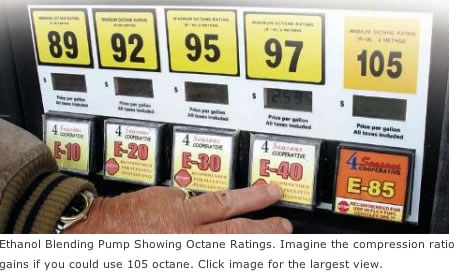
A Blender pump is shown in the photo above. These pumps allow a number of predetermined Blends of different fuels to be made and put into your gas tank.
Blender Pumps are increasing around the country. In North Dakota 60 were installed in 2010. But Blender pumps are expensive – maybe $30,000 a pop – and with all the flex-fuel manufacturing in the US, there are still around 8 million flex fuel cars out of a total US fleet of 250 million – which makes it difficult for a retailer to justify putting in a blender pump anyway. Not that, making 5-10 cents a gallon as they do, that they are howling for new fuels that bring new investment requirements, in any case.
Coskata responds with an interesting point. Pumps don’t last forever – they need to be replaced anyway, just around once every 10 years – why not simply replace a standard pump with a blender pump? That way, the conversion cost is absorbed into the normal capital replacement schedule. By 2022, you have blender pumps in broad distribution.
Should US manufacturers continue their commitment to, say, 50 percent or more of their fleet being flex-fuel enabled – by 2022, using a 17-year replacement cycle for the US fleet, perhaps as much as 33 percent of the fleet could be flex-fuel enabled, without changing the game on manufacturers.
Furthermore; “If we can develop a solid infrastructure and establish a blender pump network, within three to five years, we could potentially anticipate the pricing between regular and premium fuels to be cut in half through the availability of midlevel ethanol blends,” Vander Griend stated. “This can offer the auto industry the framework to increase compression ratio and in turn, enable the auto industry to manufacture more turbo-charged vehicles. Consumer education is paramount to this initiative. Consumers who understand octane does indeed matter because it improves mileage, provides savings at the pump, and mitigates adverse health effects, are consumers who will choose ethanol.”
So how does a Blender Pump work? In the figure below we see that there are two tanks underground, one with gasoline and the other with ethanol.
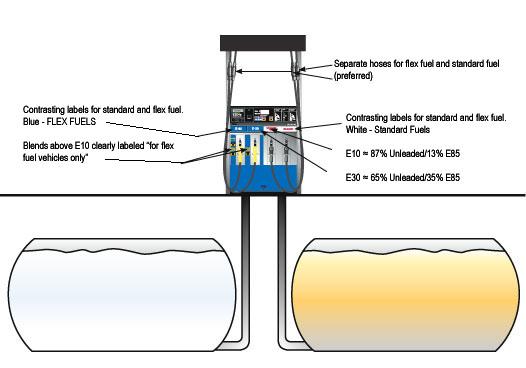
return to Ethanol Fuels Table of Contents

